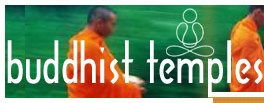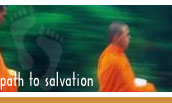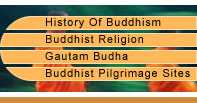Six years after his initial renunciation, he realized that extreme mortification does not lead to liberation. He arose and broke the austerities. The five ascetics got upset and left for Benares.
 As his former garments had perished, he took a yellow shroud from the corpse of a servant girl awaiting cremation nearby. To help him wash it, Indra Deva struck the ground to form a pond. A local Brahmin's daughter, Sujata, approached him and offered him a golden bowl filled with rice, prepared in the essence of the milk of one thousand cows. Renewed, he bathed and then walked to a nearby cave to continue his meditation. However, the earth shook and the voices of the earlier Buddhas resounded in the air, telling him that this was not the place of his enlightenment. They advised him to proceed to the nearby Bodhi tree. The sites, where these events took place, were seen by the Chinese pilgrims in the fifth and seventh centuries. The records mention that stupas had been constructed at each of the sites. However, none of these exist today.
As his former garments had perished, he took a yellow shroud from the corpse of a servant girl awaiting cremation nearby. To help him wash it, Indra Deva struck the ground to form a pond. A local Brahmin's daughter, Sujata, approached him and offered him a golden bowl filled with rice, prepared in the essence of the milk of one thousand cows. Renewed, he bathed and then walked to a nearby cave to continue his meditation. However, the earth shook and the voices of the earlier Buddhas resounded in the air, telling him that this was not the place of his enlightenment. They advised him to proceed to the nearby Bodhi tree. The sites, where these events took place, were seen by the Chinese pilgrims in the fifth and seventh centuries. The records mention that stupas had been constructed at each of the sites. However, none of these exist today.As Buddha walked to the Bodhi tree, Svastika, a graincutter, gave him a bundle of kusha grass. A flock of birds flew around him three times. When he entered the area around the tree, the earth shook. He made a seat from the kusha grass for himself, on the eastern side of the tree and after seven circumambulations sat down facing east. He made the great resolve of not rising again, till enlightenment had been attained, even if his skin, bones and flesh crumble away. Sending forth a beam of light from the center of his eyebrows, he invoked Mara, who came to challenge him. Mara first dispatched his horrible armies and then his enticing daughters, but Buddha remained unmoved and defeated him, calling upon the earth and her goddess as his witness. He continued in profound meditation for three nights and finally realized the Supreme Enlightenment at dawn. The air filled with flowers and light and the earth trembled seven times.
For seven days, Buddha continued to meditate beneath the tree, without moving from his seat and for the next six weeks, He remained in the vicinity. During the second week he paced, lost in thoughts, with lotus flowers springing from his footsteps. He pondered whether or not to teach. The chankramanar jewel walk later represented this event. The walk consists of a low platform adorned with eighteen lotuses, which now runs close to and parallel to the north side of the Mahabodhi Temple. For another week after the walk, He sat under the Bodhi tree. The Animeshalochana Stupa, situated to the north of the Chankramanar, later marked this spot. Brahma and Indra offered a hall made of the seven precious elements, where Buddha sat for a week, radiating lights of five colors from his body to illuminate the Bodhi tree. Huen Tsang described this site as being to the west of the tree and remarked that with time the precious elements changed to stone. Today, Ratnaghara stands identified by some as a roofless shrine to the north of Chankramanar.
During a week of unusually inclement weather, the Naga king, Muchalinda wrapped his body seven times around the meditating Buddha, protecting him from the rain, wind and insects. Huen Tsang saw a small temple next to the tank, believed to be the Naga's abode. He described it as lying to the southeast of the Bodhi tree. Presently, it is identified as the dry pond in Mucherim village near Bodhgaya.
While Buddha was meditating beneath the Ajapala nigrodha tree, Lord Brahma came and requested him to teach the Dharma. Huen Tsang saw this tree, along with a small temple and stupa beside it, at the southeast corner of the Bodhi tree enclosure. It is thought that the site is now within the Mahanta's graveyard, near the present eastern gate.
Buddha spent the seventh week seated beneath the Tarayana tree. According to the Huen Tsang, the tree lies to the southeast of the Bodhi tree enclosure, near the place where the bodhisattva earlier had bathed and eaten Sujata's offering. All these places were marked with stupas at that point of time. It was here that two passing merchants, Trapusha and Bhallika, offered Buddha food for the first time, since his enlightenment. Seeing that he needed a vessel to receive it, each of the four guardians of the directions offered precious bowls. But, He accepted only a stone bowl from each one of them. He pressed the four bowls together to form one and when Fa Hien saw it in Peshawar, four rims could be seen in the one.
 After spending forty-nine days in meditation, close to the seat of enlightenment, Buddha left Bodhgaya on foot to meet the five ascetics at Benares, where He was going to turn the first wheel of Dharma. After accomplishing this task, he returned briefly to Uruvela and introduced the three brothers, namely Uruvela, Gaya and Nadi Kasyapa, to his teachings. They, along with a thousand followers of their own, became monks and accompanied Shakyamuni to Rajgir.
After spending forty-nine days in meditation, close to the seat of enlightenment, Buddha left Bodhgaya on foot to meet the five ascetics at Benares, where He was going to turn the first wheel of Dharma. After accomplishing this task, he returned briefly to Uruvela and introduced the three brothers, namely Uruvela, Gaya and Nadi Kasyapa, to his teachings. They, along with a thousand followers of their own, became monks and accompanied Shakyamuni to Rajgir.Just like Shakyamuni, all other Buddhas who show enlightenment to this world eat a meal of milk rice, sit upon a carpet of grass at Vajrasana, engage in meditation, defeat Mara and his forces and attain supreme enlightenment beneath the Bodhi tree (although the species of tree differs with each Buddha). The present Bodhi tree is a descendant of the original, as the tree was destroyed deliberately on at least three occasions. King Ashoka, initially hostile to Buddhism, ordered it to be cut down and burned on the spot. But, when the tree sprang up anew from the flames, his attitude changed. Deep regretting his destruction, Ashoka lavished so much personal care and attention on the new tree that his queen became jealous and secretly had it destroyed once more. Again Ashoka revived it and built a protective enclosing wall, as had previously been done by King Prasenajit of Koshala, during the Buddha's lifetime. Nagarjuna is said to have built an enclosure later, to protect the tree from being damaged by elephants. With time, this became less effective. So, he placed a statue of Mahakala upon each pillar.
Huen Tsang gave a record of the third destruction of the tree. He reported seeing remains of these walls and states that in the sixth century, a Saivite king of Bengal, Shasanka, destroyed the tree. However, even though he dug deep into its roots, he was unable to unearth it completely. Purvavarma, of Magadha Empire, revived it later. He poured milk of one thousand cows upon it, leading to the growth of tree to a height of ten feet, in a single night.
The origin of the Mahabodhi Temple, which adorns the site today, is shrouded in obscurity. Various legends hold that Ashoka erected a diamond throne shrine, basically a canopy supported by four pillars, over a stone representation of Vajrasana. When General Cunningham was restoring the floor of the temple, he found traces that he took to be the remains of the shrine. It is his opinion that the temple may have been built between the fifth century and seventh century. Others propose that because of its resemblance to similar structures found in Ghandhara and Nalanda as well as the other archaeological evidence, it could have been founded as early as the second century AD. Nagarjuna is reputed to have built the original stupa upon the roof. However, from the records of Huen Tsang, we can be certain that the temple existed before the seventh century.
Records of the builder are not clear. Some legends go that he was a Brahmin, who acted on the advice of Shiva. The statue in the main shrine of the temple, famous for its likeness to Shakyamuni, is said to have been the work of Maitreya in the appearance of a Brahmin artisan.
Monastic tradition seems to have been strong in Bodhgaya. Fa Hien mentions three monasteries and Huen Tsang describes particularly the magnificent Mahabodhi Sangharama, founded in the early fourth century by a king of Ceylon. Both pilgrims make special remark of the strict observance of the Vinaya by the monks residing there. Some accounts tell that the great master Atisha, who later emphasized pure practice of the Vinaya, received ordination in Bodhgaya.
Like everywhere else, neglect and desolation followed the Muslim invasion of northern India. However, extensive repairs and restoration of the temple and environs in the fourteenth century by the Burmese and their further attempts in the early nineteenth century are recorded. In the late sixteenth century, a wandering sanyasi (ascetic) settled in Bodhgaya and founded the establishment now known as the math of the Mahanta. In 1891, Anagarika Dharmapala, inspired by appeals in the press by Sir Edwin Arnold, began the Mahabodhi Society and sought to restore the site as a Buddhist shrine. However, his efforts were hindered by bureaucracy. The British Government of India decided that the temple and its surroundings were the property of the Saivite Mahanta. Nearly sixty years of judicial wrangling followed, after which the Mahabodhi Temple was legally recognized as belonging to Buddhists.
Since the inception of the Bodhgaya Temple Management Committee and the beginning of its active administration in 1953, vast improvements have been made to both the temple and its grounds. Existing structures have been repaired and new stupas are being erected. With the reintroduction of gilded images in the niches of the Mahabodhi Temple, it began to regain some of its lost splendor. The establishment of beautiful temples and monasteries, in the surrounding district, by the people of Tibet, Japan, China, Thailand, Burma, etc has brought to Bodhgaya, the varied traditions of Buddhist practice that have evolved in those lands. By contrast, the headless, mutilated statues in the local museum present a disturbing reminder of past destruction.
Pilgrims abound in Bodhgaya. In the recent years, thousands have had the fortune to listen to the Dharma there. Many Buddhist masters are again traveling to Bodhgaya to turn the wheel of Dharma. For example, over 100,000 devotees attended the Kalachakra empowerment given by His Holiness, The Dalai Lama, in the year 1974. The Tibetan monastery now offers a two-month meditation course every year, for the international Buddhist community. It also provides meditation courses. Occasionally, the teachings are given in the Burmese, Thai, Japanese and other temples.





